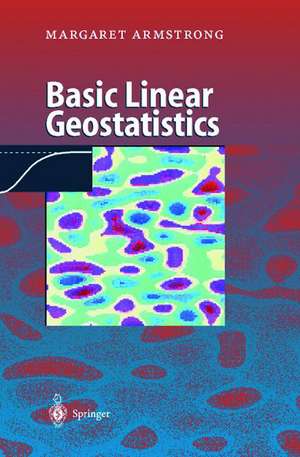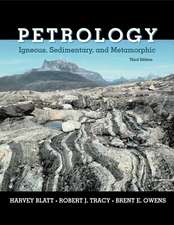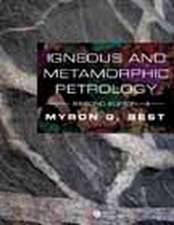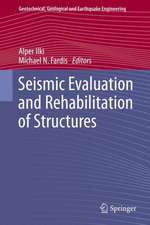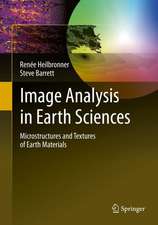Basic Linear Geostatistics
Autor Margaret Armstrongen Limba Engleză Paperback – 29 sep 1998
Preț: 522.24 lei
Preț vechi: 614.40 lei
-15% Nou
Puncte Express: 783
Preț estimativ în valută:
99.93€ • 104.62$ • 82.69£
99.93€ • 104.62$ • 82.69£
Carte tipărită la comandă
Livrare economică 05-19 aprilie
Preluare comenzi: 021 569.72.76
Specificații
ISBN-13: 9783540618454
ISBN-10: 3540618457
Pagini: 172
Ilustrații: XI, 155 p.
Dimensiuni: 155 x 235 x 9 mm
Greutate: 0.27 kg
Ediția:1998
Editura: Springer Berlin, Heidelberg
Colecția Springer
Locul publicării:Berlin, Heidelberg, Germany
ISBN-10: 3540618457
Pagini: 172
Ilustrații: XI, 155 p.
Dimensiuni: 155 x 235 x 9 mm
Greutate: 0.27 kg
Ediția:1998
Editura: Springer Berlin, Heidelberg
Colecția Springer
Locul publicării:Berlin, Heidelberg, Germany
Public țintă
GraduateCuprins
1 Introduction.- 1.1 Summary.- 1.2 Introduction.- 1.3 Applications of geostatistics in mining.- 1.4 The $64 question: does geostatistics work?.- 1.5 Introductory exercise.- 1.6 Does geostatistics work in the real world?.- 1.7 Exercises.- 2 Regionalized Variables.- 2.1 Summary.- 2.2 Modelling regionalized variables.- 2.3 Random functions.- 2.4 Stationary and intrinsic hypotheses.- 2.5 How to decide whether a variable is stationary.- 2.6 Spatial covariance function.- 2.7 Exercises.- 3 The Variogram.- 3.1 Summary.- 3.2 Definition of the variogram.- 3.3 Range and zone of influence.- 3.4 Behaviour near the origin.- 3.5 Anisotropies.- 3.6 Presence of a drift.- 3.7 Nested structures.- 3.8 Proportional effect.- 3.9 Hole effects and periodicity.- 3.10 Models for variograms.- 3.11 Admissible models.- 3.12 Common variogram models.- 3.13 Simulated images obtained using different variograms.- 3.14 Exercises.- 4 Experimental Variograms.- 4.1 Summary.- 4.2 How to calculate experimental variograms.- 4.3 In the plane.- 4.4 In three dimensions.- 4.5 Example 1: regular 1D data.- 4.6 Example 2: calculating experimental variograms in 2D.- 4.7 Variogram cloud.- 4.8 Fitting a variogram model.- 4.9 Troublesome variograms.- 4.10 Exercises.- 5 Structural Analysis.- 5.1 Summary.- 5.2 Steps in a case study.- 5.3 Case studies.- 5.4 An iron ore deposit.- 5.5 Second case study: an archaean gold deposit (M. Harley).- 5.6 Third case study: a Witwatersrand gold deposit (M. Thurston).- 6 Dispersion as a Function of Block Size.- 6.1 Summary.- 6.2 The support of a regionalized variable.- 6.3 Variance of a point within a volume.- 6.4 Variance of v within V.- 6.5 Krige’s additivity relation.- 6.6 Exercise: stockpiles to homogenize coal production.- 6.7 Change of support: regularization.- 6.8 Exercise:calculating regularized variograms.- 6.9 Exercises.- 7 The Theory of Kriging.- 7.1 Summary.- 7.2 The purpose of kriging.- 7.3 Deriving the kriging equations.- 7.4 Different kriging estimators.- 7.5 Ordinary kriging.- 7.6 The OK equations for intrinsic regionalized variables.- 7.7 Exercise: Ordinary kriging of a block.- 7.8 Kriging the value of the mean.- 7.9 Simple kriging.- 7.10 The additivity theorem.- 7.11 Slope of the linear regression.- 7.12 Kriging is an exact interpolator.- 7.13 Geometric exercise showing the minimization procedure.- 7.14 Exercises.- 8 Practical Aspects of Kriging.- 8.1 Summary.- 8.2 Introduction.- 8.3 Negative weights.- 8.4 How the choice of the variogram model affects kriging.- 8.5 Screen effect.- 8.6 Symmetry in the equations.- 8.7 Testing the quality of a kriging configuration.- 8.8 Cross-validation.- 9 Case Study using Kriging.- 9.1 Summary.- 9.2 Iron ore deposit.- 9.3 Point kriging using a large neighbourhood.- 9.4 Block kriging using a large neighbourhood.- 9.5 Point kriging using smaller neighbourhoods.- 9.6 Kriging small blocks from a sparse grid.- 10 Estimating the Total Reserves.- 10.1 Summary.- 10.2 Can kriging be used to estimate global reserves?.- 10.3 Extension variance.- 10.4 Relationship to the dispersion variance.- 10.5 Area known to be mineralized.- 10.6 When the limits of the orebody are not known a priori.- 10.7 Optimal sampling grids.- 10.8 Exercises.- Appendix 1: Review of Basic Maths Concepts.- A1 What maths skills are required in linear geostatistics.- A1.1 Means and variances.- A1.2 Single and double summations.- A1.3 Exercises using summations.- Appendix 2: Due Diligence and its Implications.- A2.1 Stricter controls on ore evaluation.- A2.2 Due diligence.- A2.3 The logbook.- References.- Author Index.
Caracteristici
Reviews underlying theory in more detail than other books * Links theory to applications * Based on a postgraduate course * A set of exercises is integrated into the text
